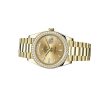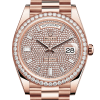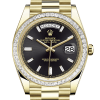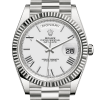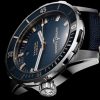
The Rolex Day-Date was introduced a few years before the death of Rolex founder Hans Wilsdorf. It was the first timepiece from the famous brand that could display the day and date on the dial at the same time. In 1956, two references – 6510 (domed bezel) and 6511 (fluted bezel) – of the watch were released. The Rolex Day-Date went on to become the flagship watch of the collection. It was available in only 18-carat gold (yellow, white and rose) and platinum.
While a new reference (6611) arrived in 1957, the previous 6510 and 6511 references went with the previous year. 6611 came with an advanced model of the Calibre 1055 movement. Production of this reference was later halted in 1959. Over the years, Rolex has released different variants of the Day-date, with the watch often remarked as a symbol of success. Being the luxury flagship timepiece of Rolex, several leaders, celebrities and influential people around the world have been seen wearing it. Very impressive, right? No doubt.
Years later, Rolex introduced new variants: Day-Date 36mm, Day-Date II and Day-Date 40mm. The Day-Date II was released after the 36mm variant. When the Day-Date II was discontinued, Rolex launched a larger version of their flagship – Day-Date 40.
Before we move on to review the Rolex Day-Date 36mm and 40mm, here is an interesting fact: right from the days of the earlier releases, the Day-Date has always offered a weekday indicator (previously available in 24 different languages, now 26).
Dial
Both Day-Date 36 and 40mm collections come already attached with so much personality and messaging to a unique set of watch connoisseurs, although it still has a mass appeal. In most cases, that is an excellent thing, as it implies owners of luxury timepieces such as these get precisely what they are paying for – and that is instant, confident identification when people see the watch.

The Day-Date 36mm is a smaller watch, compared to the standard of most men’s luxury timepieces. This watch is produced in different variants, each of these variants accompanied by various dials. The yellow gold model features a green dial, the white gold variant has a blue dial and the Everose version has brown dials. Each dial is furnished with eight brilliant-cut diamonds and two baguette-cut diamonds placed at both nine and six o’clock.
The fluted bezel can also be switched for a gem-set bezel, with fifty-two brilliant-cut diamonds. If that is not enough, you can upgrade to a high-jewellery setting for the watch. The centre links of the ‘President’ bracelet can be laced with brilliant-cut diamonds. The newer 36mm Day-date watches have dials available in diverse colours and styles. It can have a full pavé dial, whilst the yellow gold model even features a turquoise dial. The day window is at twelve o’clock while the date window is fixed at three o’clock.

This Day-Date 40mm is 12mm thick with the white gold variant sporting a blue dial (similar to the 36mm model). What makes this version unique compared to the 36mm model, is the availability of Roman numeral hour markers on the dial. Both models, however, can have either classic hour markers or gem-set hour markers. The hour markers are baton-shaped with no lume which might come as a disappointment to most. Just above the dial is a flat sapphire crystal with AR coating on the underside.
The “Rolex” name is engraved into the inner metal flange circle that surrounds the dial further emphasising the class and prestige associated with the watch. The dial is now available in somewhat eccentric styles – coloured dials, gem-set dials and diamond-paved dials all now available. This has brought finesse and elegance back to the “watch of presidents.” The Day-Date 40mm is available with a smooth, fluted or gem-set bezel, with the 36mm variant available only with a fluted or gem-set bezel. The fluted bezel comprises of 76 thin notches. Both timepiece models also feature a direct adjustment crown.
Case
The case-fronts for both Day-Date models are equipped with sapphire crystal and cyclops-lens over the date for optimum readability. The watches possess a screw-down, twin lock winding crown and have a water resistance capacity of 100 meters. The watch cases utilise very high-quality 18-ct white, yellow and their own patented ‘Everose’ gold. For watch lovers looking to go that extra step further, there is also a platinum model available for the 40mm variant. Both 36mm and 40mm variants are only available in the famous Rolex ‘oyster’ shapes.

The watches have a distinct accuracy of ± 2 seconds daily. Both Day-Date 36 and 40mm are driven by the ‘superlative performance’ of the Caliber 3255 movement. It is an automatic movement with efficient high technology features like high Paraflex shock absorbers and Parachrom hairspring resistant to temperature changes and magnetic fields beats at a 28,800vph frequency rate. The power reserve is around 70 hours.
The advanced calibre 3255 movement is also equipped with the optimised-geometry Chronergy escapement. Rolex claims this provides a 15% increase in efficiency, in energy delivery from this alone. Its Parachrom balance spring (niobium-zirconium) and nickel-phosphorus lever with an escape wheel, makes the timepiece very resistant to magnetism. When it was released, the 3255 was the first movement to be controlled to the new Superlative Chronometer standard of -2/+2 seconds maximum deviation daily rates (the only ‘Rollie’ which subsequently stretched the movement across its whole product line).

Wearability
Both Day-Date 36 and 40 use the infamous President bracelet; it has a three-link design with heavily bowed links. The polished centre is connected with the brushed outer links, and this exhibits a signature Rolex look which adds a technical allure to the design that prevents it from appearing too bright or glistening. The bracelet also protects the links from wear and tear. There are white ceramic straws which prevent the screws and the gold or platinum links from tearing or cutting off.
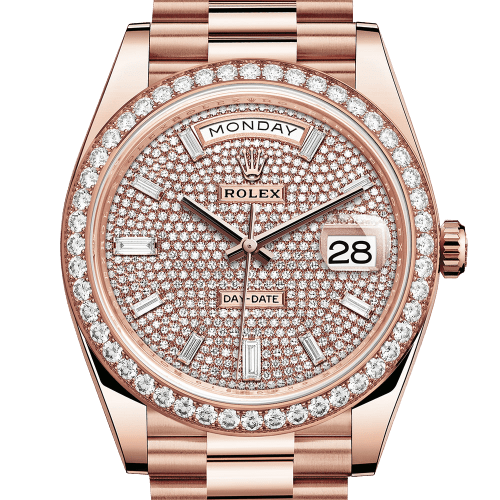
The Day-Date 36mm, however, has a uniqueness, as it allows for diamond-set versions of the president bracelet. Wearing and removing the watch is quite simple, with the tiny clearances between the links to help take the watch on and off. Very fast and easy. The bracelet opens easily by just using a fingernail to usurp the crown-shaped clasp. The bracelet material is the same quality as the case material, meaning there is elegant quality all round.
Price
Rolexes are often known for their ability to retain value, with some even increasing in value after many years. The prestige, craftsmanship and jewellery alone make the prices for these timepieces a worthwhile investment. The Day-Date 36mm Yellow gold base model starts at around £26,700, whilst the white-gold variant starts at around £28,500. The Everose gold Day-Date starts from £31,000. The more premium, gem and diamond-set models are mainly priced on request.

Some pieces however such as the Day-Date 36mm Yellow-gold with a diamond-set bezel and hour markers sell for around £40,050. The top of the range 36mm yellow-gold with a diamond-set dial, bracelet and bezel with gem-set hour markers currently retails for around £100,500.
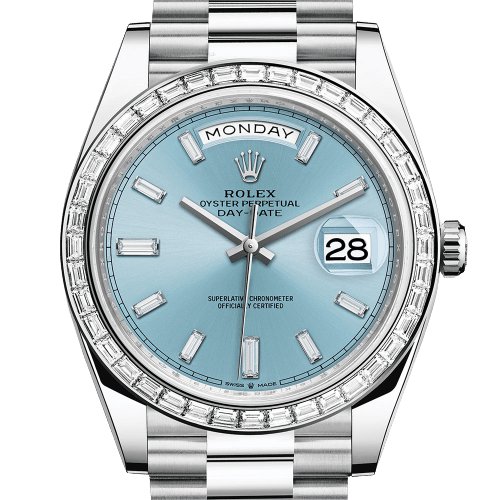
The Day-Date 40mm model has similar base prices for the entry versions (between £24,000-27,000). A top-line Day-Date 40mm white gold watch with a diamond-set dial and bezel, and gem-set hour markers, currently retails for about £68,500. A platinum 40mm model with a diamond bezel and gem-set hour markers is currently selling for around £93,300. The plain platinum variant is around £53,400. As mentioned prices can be different as these are priced on request.








